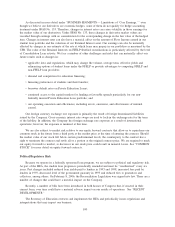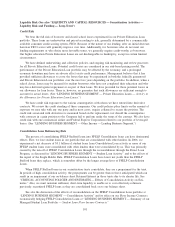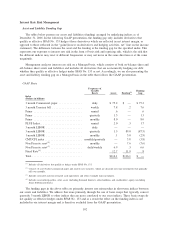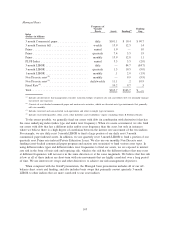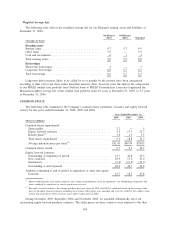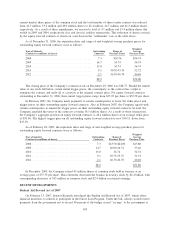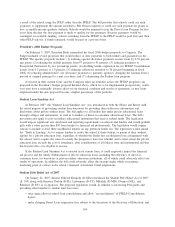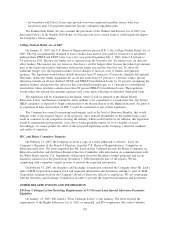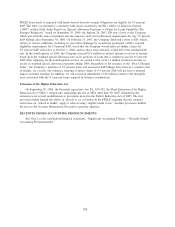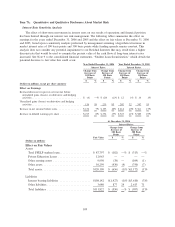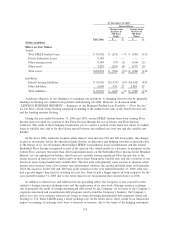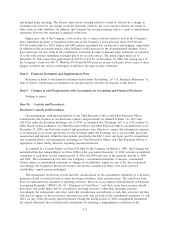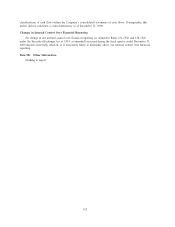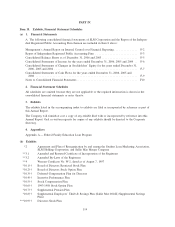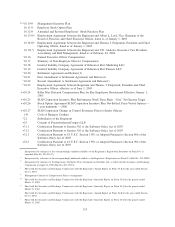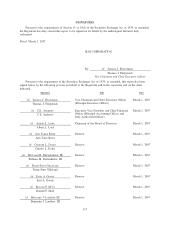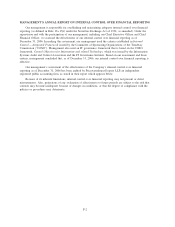Sallie Mae 2006 Annual Report Download - page 111
Download and view the complete annual report
Please find page 111 of the 2006 Sallie Mae annual report below. You can navigate through the pages in the report by either clicking on the pages listed below, or by using the keyword search tool below to find specific information within the annual report.
Fair Value $ % $ %
Change from
Increase of
100 Basis
Points
Change from
Increase of
300 Basis
Points
Interest Rates:
At December 31, 2005
(Dollars in millions)
Effect on Fair Values
Assets
Total FFELP student loans. . .................. $ 76,492 $ (215) —% $ (385) (1)%
Private Education Loans . . . .................. 9,189 — — — —
Other earning assets ........................ 9,344 (57) (1) (164) (2)
Other assets .............................. 7,429 (292) (4) (377) (5)
Total assets ............................... $102,454 $ (564) (1)% $ (926) (1)%
Liabilities
Interest bearing liabilities . . .................. $ 92,026 $(1,437) (2)% $(3,612) (4)%
Other liabilities ............................ 3,609 975 27 2,863 79
Total liabilities ............................ $ 95,635 $ (462) —% $ (749) (1)%
A primary objective in our funding is to minimize our sensitivity to changing interest rates by generally
funding our floating rate student loan portfolio with floating rate debt. However, as discussed under
“LENDING BUSINESS SEGMENT — Summary of our Managed Student Loan Portfolio — Floor Income,”
we can have a fixed versus floating mismatch in funding if the student loan earns at the fixed borrower rate
and the funding remains floating.
During the year ended December 31, 2006 and 2005, certain FFELP student loans were earning Floor
Income and we locked in a portion of that Floor Income through the use of futures and Floor Income
Contracts. The result of these hedging transactions was to convert a portion of the fixed rate nature of student
loans to variable rate, and to fix the relative spread between the student loan asset rate and the variable rate
liability.
In the above table, under the scenario where interest rates increase 100 and 300 basis points, the changes
in pre-tax net income before the unrealized gains (losses) on derivative and hedging activities is primarily due
to the impact of (i) our off-balance sheet hedged FFELP Consolidation Loan securitizations and the related
Embedded Floor Income recognized as part of the gain on sale, which results in a decrease in payments on the
written Floor contracts that more than offset impairment losses on the Embedded Floor Income in the Residual
Interest; (ii) our unhedged on-balance sheet loans not currently having significant Floor Income due to the
recent increase in interest rates, which results in these loans being more variable rate; and (iii) a portion of our
fixed rate assets being funded with variable debt. The first item will generally cause income to increase when
interest rates increase from a low interest rate environment, whereas, the second and third items will generally
offset this increase. In the 100 and 300 basis point scenario for the year ended December 31, 2006, item (iii)
had a greater impact than item (i) resulting in a net loss. Item (i) had a bigger impact in both scenarios for the
year ended December 31, 2005 due to the lower interest rate environment that existed relative to 2006.
In addition to interest rate risk addressed in the preceding tables, the Company is also exposed to risks
related to foreign currency exchange rates and the equity price of its own stock. Foreign currency exchange
risk is primarily the result of foreign denominated debt issued by the Company. As it relates to the Company’s
corporate unsecured and securitization debt programs used to fund the Company’s business, the Company’s
policy is to use cross currency interest rate swaps to swap all foreign denominated debt payments (fixed and
floating) to U.S. dollar LIBOR using a fixed exchange rate. In the tables above, there would be an immaterial
impact on earnings if exchange rates were to decrease or increase, due to the terms of the hedging instrument
110


